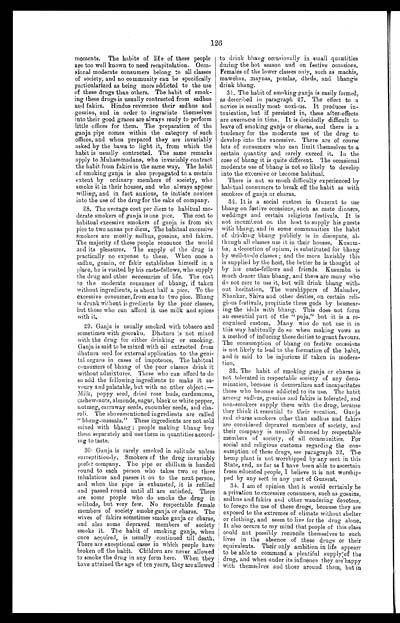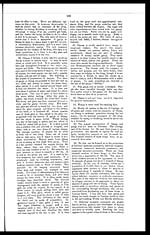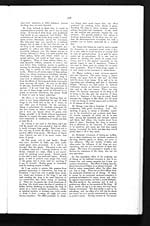Medicine - Drugs > Report of the Indian Hemp Drugs Commission, 1894-1895 > Volume VII > Evidence of Bombay witnesses
(144) Page 126
Download files
Individual page:
Thumbnail gallery: Grid view | List view

126
moments. The habits of life of these people
are too well known to need recapitulation. Occa-
sional moderate consumers belong to all classes
of society, and no community can be specifically
particularized as being more addicted to the use
of these drugs than others. The habit of smok-
ing these drugs is usually contracted from sadhus
and fakirs. Hindus reverence their sadhus and
gosains, and in order to ingratiate themselves
into their good graces are always ready to perform
little offices for them. The preparation of the
ganja pipe comes within the category of such
offices, and when prepared they are invariably
asked by the bawa to light it, from which the
habit is usually contracted. The same remarks
apply to Muhammadans, who invariably contract
the habit from fakirs in the same way. The habit
of smoking ganja is also propagated to a certain
extent by ordinary members of society, who
smoke it in their houses, and who always appear
willing, and in fact anxious, to initiate novices
into the use of the drug for the sake of company.
28. The average cost per diem to habitual mo-
derate smokers of ganja is one pice. The cost to
habitual excessive smokers of ganja is from six
pice to two annas per diem. The habitual excessive
smokers are mostly sadhus, gosains, and fakirs.
The majority of these people renounce the world
and its pleasures. The supply of the drug is
practically no expense to them. When once a
sadhu, gosain, or fakir establishes himself in a
place, he is visited by his caste-fellows, who supply
the drug and other necessaries of life. The cost
to the moderate consumer of bhang, if taken
without ingredients, is about half a pice. To the
excessive consumer, from one to two pice. Bhang
is drunk without ingredients by the poor classes,
but those who can afford it use milk and spices
with it.
29. Ganja is usually smoked with tobacco and
sometimes with gooraku. Dhatura is not mixed
with the drug for either drinking or smoking.
Ganja is said to be mixed with oil extracted from
dhatura seed for external application to the geni-
tal organs in cases of impotence. The habitual
consumers of bhang of the poor classes drink it
without admixtures. Those who can afford to do
so add the following ingredients to make it sa-
voury and palatable, but with no other object:—
Milk, poppy seed, dried rose buds, cardamoms,
cashew-nuts, almonds, sugar, black or white pepper,
nutmeg, carraway seeds, cucumber seeds, and cha-
roli. The abovementioned ingredients are called
"bhang-massala." These ingredients are not sold
mixed with bhang; people making bhang buy
them separately and use them in quantities accord-
ing to taste.
30. Ganja is rarely smoked in solitude unless
surreptitiously. Smokers of the drug invariably
prefer company. The pipe or chillum is handed
round to each person who takes two or three
inhalations and passes it on to the next person,
and when the pipe is exhausted, it is refilled
and passed round until all are satisfied. There
are some people who do smoke the drug in
solitude, but very few. No respectable female
members of society smoke ganja or charas. The
wives of fakirs sometimes smoke ganja or charas,
and also some depraved members of society
smoke it. The habit of smoking ganja, when
once acquired, is usually continued till death.
There are exceptional cases in which people have
broken off the habit. Children are never allowed
to smoke the drug in any form here. When they
have attained the age of ten years, they are allowed
to drink bhang occasionally in small quantities
during the hot season and on festive occasions.
Females of the lower classes only, such as machis,
mawchas, maynas, pomlas, dheds, and bhangis
drink bhang.
31. The habit of smoking ganja is easily formed,
as described in paragraph 27. The effect to a
novice is usually most noxious. It produces in-
toxication, but if persisted in, these after-effects
are overcome in time. It is decidedly difficult to
leave off smoking ganja or charas, and there is a
tendency for the moderate use of the drug to
develop into the excessive. There are of course
lots of consumers who can limit themselves to a
certain quantity and rarely exceed it. In the
case of bhang it is quite different. The occasional
moderate use of bhang is not so likely to develop
into the excessive or become habitual.
There is not so much difficulty experienced by
habitual consumers to break off the habit as with
smokers of ganja or charas.
32. It is a social custom in Guzerat to use
bhang on festive occasions, such as caste dinners,
weddings and certain religious festivals. It is
not incumbent on the host to supply his guests
with bhang, and in some communities the habit
of drinking bhang publicly is in disrepute, al-
though all classes use it in their houses. Kusum-
ba, a decoction of opium, is substituted for bhang
by well-to-do classes; and the more lavishly this
is supplied by the host, the better he is thought of
by his caste-fellows and friends. Kusumba is
much dearer than bhang, and there are many who
do not care to use it, but will drink bhang with-
out hesitation. The worshippers of Mahadev,
Shankar, Shiva and other deities, on certain reli-
gious festivals, propitiate these gods by besmear-
ing the idols with bhang. This does not form
an essential part of the "puja," but it is a re-
cognised custom. Many who do not use it in
this way habitually do so when making vows as
a method of inducing these deities to grant favours.
The consumption of bhang on festive occasions
is not likely to lead to the formation of the habit,
and is said to be injurious if taken in modera-
tion.
33. The habit of smoking ganja or charas is
not tolerated in respectable society of any deno-
mination, because it demoralizes and incapacitates
those who become addicted to its use. The habit
among sadhus, gosains and fakirs is tolerated, and
non-smokers supply them with the drug, because
they think it essential to their vocation. Ganja
and charas smokers other than sadhus and fakirs
are considered depraved members of society, and
their company is usually shunned by respectable
members of society, of all communities. For
social and religious customs regarding the con-
sumption of these drugs, see paragraph 32. The
hemp plant is not worshipped by any sect in this
State, and, as far as I have been able to ascertain
from educated people, I believe it is not worship-
ped by any sect in any part of Guzerat.
34. I am of opinion that it would certainly be
a privation to excessive consumers, such as gosains,
sadhus and fakirs and other wandering devotees,
to forego the use of these drugs, because they are
exposed to the extremes of climate without shelter
or clothing, and seem to live for the drug alone.
It also occurs to my mind that people of this class
could not possibly reconcile themselves to such
lives in the absence of these drugs or their
equivalents. Their only ambition in life appears
to be able to command a plentiful supply of the
drug, and when under its influence they are happy
with themselves and those around them, but in
Set display mode to: Large image | Zoom image | Transcription
Images and transcriptions on this page, including medium image downloads, may be used under the Creative Commons Attribution 4.0 International Licence unless otherwise stated. ![]()
| India Papers > Medicine - Drugs > Report of the Indian Hemp Drugs Commission, 1894-1895 > Volume VII > Evidence of Bombay witnesses > (144) Page 126 |
|---|
| Permanent URL | https://digital.nls.uk/74910969 |
|---|




